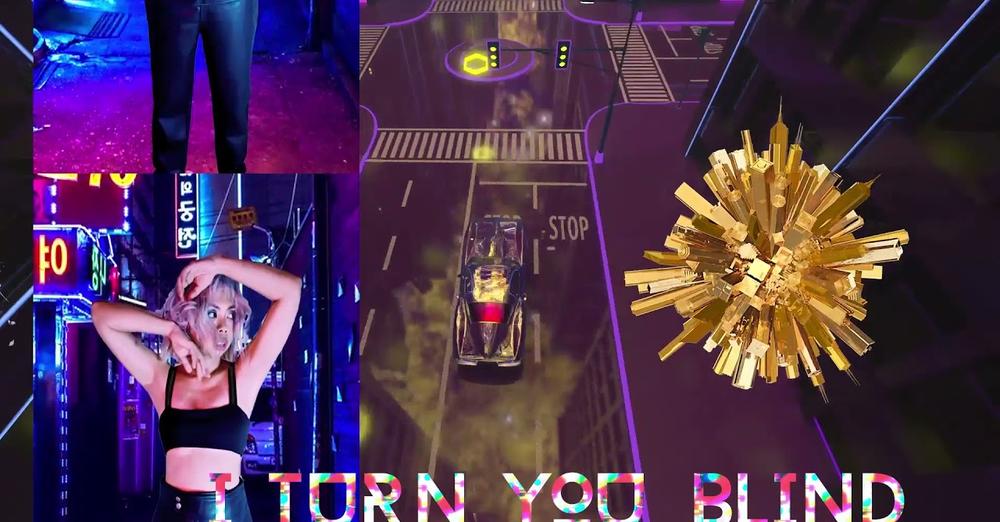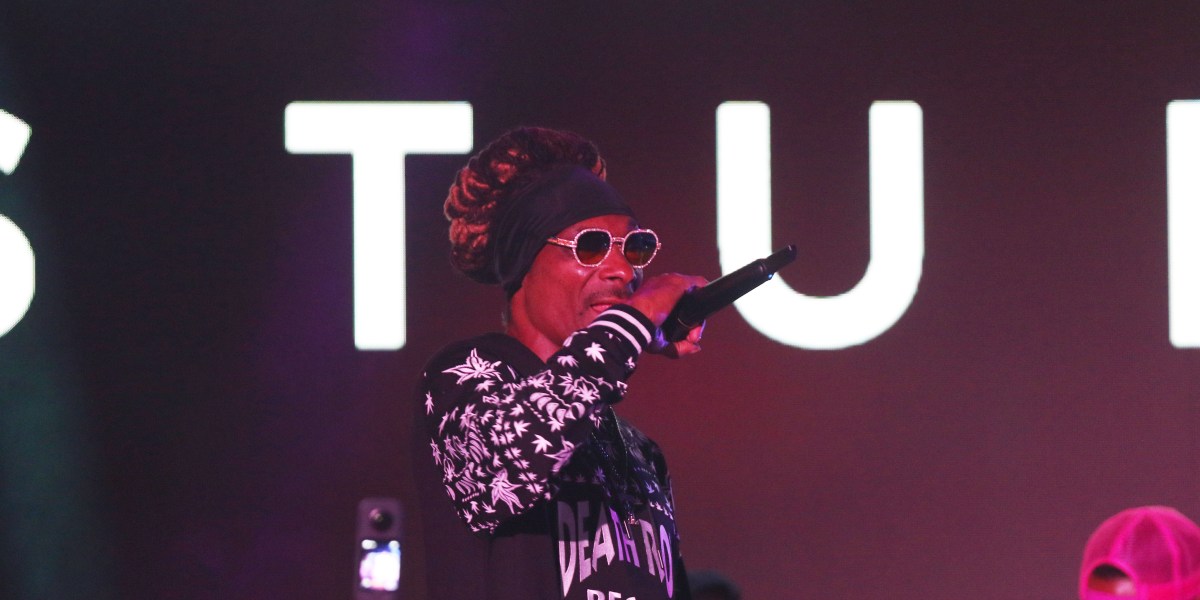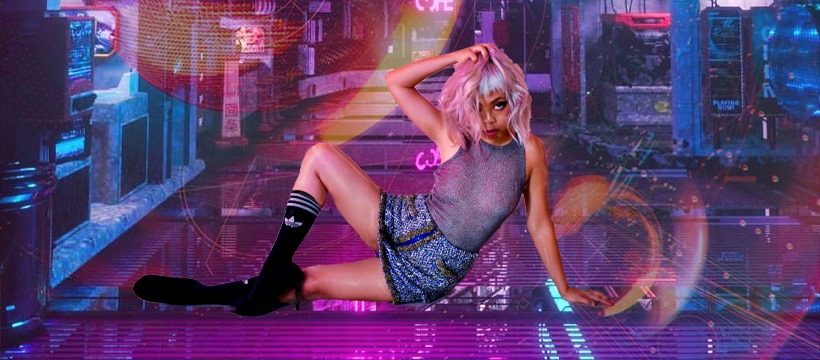LÂLKA: Among artists and fans, music NFTs are still mostly marketed as ‘digital collectables’ — the virtual equivalent of vinyl, ticket stubs or merch. But there’s a new wave of artists experimenting with innovative ways to use the technology, by asking the question ‘what else could this token symbolise’?
For artists in the music industry, these experiments in symbolism can help address a lack of transparency around copyright. For a long time, musicians have struggled with confusion around who owns which rights, what they’re entitled to as creators, and how to share income with their collaborators. And for good reason. Copyright law is messy, and it varies between countries, artforms or even between instruments.
So how can rights and agreements be communicated more clearly?
Brisbane artist LÂLKA is an innovator in this field, who describes herself as making ‘effervescent glitch future club music’. With an ear for experimental electronic music and a strong visual aesthetic, she’s the perfect candidate to join a new wave of musicians exploring NFTs.

LÂLKA: First collection
LÂLKA’s first NFT collection is centred around her upcoming mixtape, Romance + Rebellion. Three of the tracks on the mixtape will have an accompanying NFT, each sold with unique artwork and a copy of the song.
But what’s unique about LÂLKA’s project is that as well as being collectables, her NFTs also include ‘remix rights’. Each NFT gives the holder downloadable stems of the track, and permission to use them to create, distribute and monetise remixes. Remixes are a strong fit for LÂLKA and her audience.
“I realised that most of the people who follow me tend to be creatives as well,” she said. “I have people hitting me up going “oh, can I have the stems to remix this. So I guess that kind of triggered my thought process.”
But how can an NFT be used to let someone remix a track? LÂLKA’s project is a great case study in how independent artists are exploring new uses for digital tokens, while navigating the confusing junction between NFTs and copyright law.
Importantly, it also helps answer the question ‘why’? Why use an NFT to facilitate a remix?
To get some answers, let’s explore the details of her project.
What do you get with a Romance + Rebellion NFT?
Purchasing an NFT from the Romance + Rebellion mixtape gets you three types of rewards:
1. Collectible elements: ownership of one-off digital artwork, a copy of the song.
2. Unlockable elements: exclusive video content, private early access to the mixtape, downloadable stems of the song.
3. Let’s call this the ‘empowerment element’: the secret component that lets you distribute and monetise a remix.
Remixing via NFTs isn’t new, with high-profile artists like Snoop Dogg dropping instrumentals, acapellas and stems as music NFTs that encourage holders to create their own versions of the song. But in this example, NFT holders received nothing that outlined whether their remixes could be released or monetised. It’s a grey, sludgy legal swamp.

So how can NFTs empower you to remix a song, and distribute your remix? Do you just need access to the stems? To own the copyright? What’s this ‘empowerment element’?
How do you distribute song stems with an NFT?
Let’s start with the easy bit, the stems. These are the separate components of a song (drums, vocals, pads etc) made available as individual audio files. It’s not impossible to remix songs without stems, but it’s harder.
In 2021, producer Timbaland auctioned off individual stems from his EP Opera Noir as music NFTs, and fans could access an app to create a custom remix. So selling each stem as an individual NFT is one way to distribute them.
But LÂLKA says that she wanted to give NFT holders all of the song’s stems, not sell them individually. Providing a buyer with access to the audio files was the first logistical problem she faced, and she acknowledges that it’s still a clumsy system.
Web3
“I think because Web3 is so new, to my knowledge there isn’t an ideal platform where whoever buys the NFT immediately gets access and the stems just download to their computer. So what I actually have to do is contact the buyer and then send them a Dropbox link. I’ve heard arguments where people are kind of against the idea of NFTs and artists using it this way, because they’re like, “well, you don’t need the blockchain to do that, you could just have someone buy it on your Patreon. And I’m like, true,” she says.
But it’s this ability to have this kind of direct, peer-to-peer relationship with verified NFT holders that is interesting to LÂLKA.
“It’s recorded on the blockchain that they own that token, that NFT. And everyone has a wallet address that’s unique to them, so you can contact them through their wallet address.”
Music-NFTs allow her to connect directly with her “most ardent supporters in order to retroactively reward them.” It’s this ability to form decentralised, peer-to-peer relationships that is one of the big draws of NFTs for artists, many of whom are tired of paying to reach their own followers on social platforms.
Can the NFT holder make money off their remix?
In this example, LÂLKA is clear that the primary goal for handing over her stems is to give fans enjoyment:
“The main idea behind the stems is that they can just play with it — some people just want to play with stems and make their own edits,” she says. But it was important for her that NFT owners could still release and monetise their remixes.
“It would kind of suck for a producer if they made a remix that blew up, but then couldn’t claim any royalties from it.”
She points to a recent example of producer Medasin, who was paid a small fee to remix Kučka’s track ‘Honey’. When the remix took off unexpectedly, Medasin wasn’t entitled to a cut.
“This producer was only paid a producer fee. But then, the song blew up. He could have made a tonne of money with royalties, if that was in the original agreement, but it wasn’t.”
“Not throwing shade at Kučka or her team at all. It was just one of those things that maybe wasn’t thought of in advance.”
In contrast, LÂLKA wants NFT holders to share in royalties for their remixes. How?
Her solution to this is pragmatic.
“If someone else makes a remix, I still own the publishing royalties seeing as I wrote the song, but they get to earn money from the sound that they make using my stems,” she says.
NFT holders
In other words, the NFT holder gets to keep master royalties for the new remix that they create. If that makes perfect sense to you, skip the next bit! If not – here’s music copyright 101:
A song contains two main types of copyright. The first is in the ideas that make up a song; things like lyrics and melodies. Once, this would be printed as sheet music, and sold by publishers.
These composition rights are still called ‘publishing rights’.
The other kind of copyright is in the recording. Once, performers would sing into a horn which would etch their voice onto a record. This ‘master recording’ would be copied onto more records to sell.
These sonic rights are still called ‘master rights’.
You buy the NFT. You create a remix. And you can keep the master royalties (eg. Spotify streaming income), LÂLKA keeps the publishing royalties.
LÂLKA has a pretty clear vision for the rights she wants to give the NFT holder. But how can she actually hand over these rights?
How do you use an NFT to give permission to remix a song?
We’ll talk about legalities in a second, but it’s important not to forget the power of reputational, social contracts. LÂLKA says that transparency provides the strongest incentive to honour her promise:
“I’m putting the terms and conditions on my website, and I’ve been public about it on socials. So as an artist, I’ve got to honour that. It’d be embarrassing if I didn’t honour that agreement that I’ve so publicly made.”
Making the terms and conditions public is one way for artists to build trust and maintain accountability. But public shame is not legally binding. If the promise is to have legal weight, it needs to fit into some kind of legal framework.
Should artists hand over their copyright in an NFT?
One way to prevent NFT holders from infringing on copyright would be to sell them the underlying copyrights to the original song. This was what blockchain big dog 3LAU did with the sale of WAVEFORM, an original one-off music NFT that was sold with “full mastering, copyright, and publishing rights”. You can’t infringe on someone’s copyright if you own it, yeah?
But what if you’re a musician who wants to keep the copyright in your original song, and just share the rights to create a remix? A better bet for most artists would be (drumroll) … A licence.
What’s a music license?
Music licenses give you the rights to use a copyrighted work in a certain way — eg. to press it on vinyl, or use it as the theme to your YouTube channel. They don’t re-assign the ownership of the original song’s copyright. For this reason, licenses can sometimes be more informal, and don’t necessarily have to be signed. Marcus Walkom, a partner at Media Arts Lawyers, says that this means the rights to remix a track could be licensed by exchanging an NFT.
“If the NFT is specifically for the right to create and exploit a remix – provided any rights holders agree and grant the specific licence (ie artist and record label) – then you could attach those underlying rights to the NFT,” Marcus said.
However, he clarifies that “there should always be terms associated with any NFT and without an explicit licence around the rights attached to the NFT (and further details around other specific terms i.e. usage and income share etc) then there’s potential for disputes in the future around any exploitation of those rights by the purchaser.
Given there is a licence of rights attached to a copyright this should be covered by an express written licence”.

So is that the secret empowerment element?
Yep. The secret empowerment element included in LÂLKA’s NFTs is… A remix licence agreement. Another challenge that she came up against was how to actually integrate this licence agreement into an NFT. Her solution is pragmatic:
“It’s going to be written formally on a document as a PDF.”
Including a downloadable pdf with an NFT seems like adding a lumpy legal wart on a smooth blockchain baby backside. Like sending stems to fans via a Dropbox link, it’s not the seamless, high-tech solution that we tend to associate with blockchain tech.
But so far, keeping it old-school with paperwork seems to be the most practical approach to the copyright teething pains surrounding NFTs. Grammy award winning producer Illmind also used this tactic when selling an NFT-backed ‘melody pack’, which gave holders the rights to remix and release the audio samples as new works.
Marcus Walkom agrees that for now, it’s probably the best approach:
“An express written licence should cover off the terms associated with the licence and ultimate usage by the licensee/purchaser. Any absence of an express written licence may lead to issues down the track.”
But all of this raises the question: if it’s a written agreement that’s doing the legal heavy lifting, why use an NFT at all? Couldn’t you just sell the same licence on paper, with fiat currency?
Why would artists use an NFT as a music licence?
As a case-study, LÂLKA’s Romance + Rebellion project shows that for now, music NFTs are no magic bullet to legal contracts, paperwork and download links.
But the project gives a glimpse into a bigger picture that’s unfurling, and hints at how NFTs might be used in the near future.
For now, the most popular way to think about music NFTs has been as collectables:
something you own to show affiliation, like vinyl or merch. And LÂLKA’s NFTs have this aspect to them too, with unique artwork and a limited ‘digital pressing’ of the track.
But, she says, “not everybody wants to have ownership of a song.”
This thinking represents a shift in the way creatives are engaging with NFTs. Artists are using tokens to represent concepts other than ownership.
Physical NFTs
Humans have always used physical NFTs — wax seals, keys, crowns, receipts, lottery tickets, wedding rings, ID cards, certificates — to represent important things. These objects work by taking complicated concepts and distilling them into a simple physical object.
These examples are relevant because they help answer the question at hand. If blockchain technology isn’t really the force facilitating LÂLKA’s exchange of stems and licences, why use an NFT at all?
In my opinion, it’s because there’s something ancient and deeply human about using items, objects, trinkets or talismans to symbolise information. They make things easier to understand, and that’s important. And increasingly, it doesn’t matter if these objects are physical or digital.
Right now, using NFTs to exchange music licences remains mostly symbolic, like the ring ceremony at a wedding, or the coronation of a king.
But this isn’t a criticism. Because it’s this symbolic power that makes an NFT vastly more appealing — and therefore functional — than selling a legal PDF on your website.
It’s also the reason why innovative artists like LÂLKA are important. Because in the process of using tokens in new symbolic ways, they help to solve long standing problems around clarity and transparency.
Learn more about LÂLKA’s Romance + Rebellion project here. The first edition dropped on Thursday 18th November – find it on Zora here.





